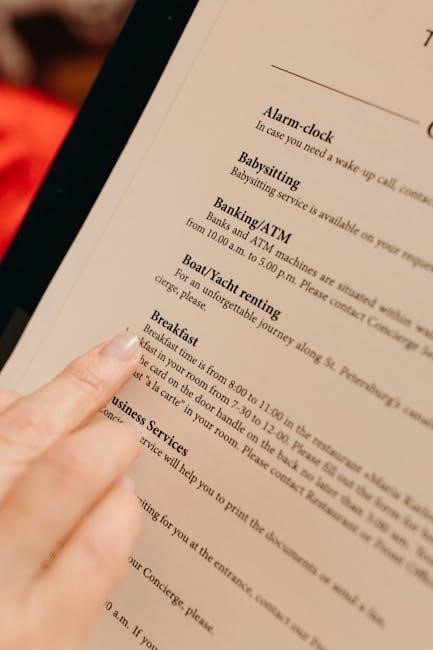The Pathfinder 2e Sorcerer is a versatile spellcaster, harnessing innate magical abilities tied to their bloodline․ Perfect for newcomers and veterans, this class excels at adaptability and power․
Overview of the Sorcerer Class
The Sorcerer is a spellcasting class in Pathfinder 2e, drawing power from a mystical bloodline․ They excel at both offense and utility, making them versatile in any party․ With access to a wide range of spells, sorcerers can adapt to various combat and exploration scenarios․ Their abilities are innate, allowing for spontaneous casting without preparation․ This class is ideal for players who enjoy flexibility and high damage output․ Sorcerers are easy to learn for newcomers while offering depth for experienced players․
- Innate spellcasting ability tied to their bloodline heritage․
- Spontaneous casting allows for dynamic spell selection․
- VERSATILE in both combat and exploration scenarios․
Key Features and Abilities
Sorcerers in Pathfinder 2e possess unique features that set them apart․ Their magic is innate, tied to their bloodline, granting them access to powerful spells and abilities․ Key features include spell slots, bloodline powers, and heightened spells․ Bloodlines like Abjurer or Angelfire offer distinct playstyles, with unique abilities enhancing their magical prowess․ Sorcerers also benefit from flexible casting, allowing them to adapt spells to different situations․ Their spells range from damage-dealing evocations to protective abjurations, making them versatile in combat and exploration․ This flexibility ensures sorcerers remain effective at all levels of play․
- Bloodline Powers: Unique abilities tied to their heritage․
- Spell Slots: Determine the number and level of castable spells․
- Heightened Spells: Enhance spell effects as the sorcerer levels up․
- Flexible Casting: Adapt spells to fit various combat needs․

Choosing the Right Bloodline
Selecting a bloodline defines your sorcerer’s identity, offering unique abilities and playstyles․ Each bloodline, like Abjurer or Angelfire, provides distinct powers and thematic flavor․
Abjurer Bloodline
The Abjurer Bloodline grants defensive and protective magic, perfect for those who prefer to shield allies and control the battlefield․ Key abilities include Protective Ward, which provides a boost to Armor Class, and Healing Bond, allowing the sorcerer to channel restorative energy․ This bloodline is ideal for players seeking a supportive role, combining elemental resistance with potent protective spells․ The Abjurer excels in maintaining party safety while contributing to combat through strategic spell use․
Angelfire Bloodline
The Angelfire Bloodline channels divine energy, focusing on radiant power and celestial magic․ Sorcerers with this bloodline gain access to abilities like Heavenly Radiance, which unleashes bursts of divine fire, and Celestial Resistance, granting immunity to poison and disease․ This bloodline excels at dealing area damage while bolstering allies, making it ideal for players seeking a radiant, inspiring presence on the battlefield․ Its abilities emphasize both offensive and supportive playstyles, blending fiery destruction with divine protection․
Bloodlines and Their Unique Abilities
Bloodlines define a sorcerer’s magical heritage, shaping their abilities and playstyle․ Each bloodline offers distinct powers tied to its theme, such as celestial, shadow, or draconic origins․ They grant unique spells, class feats, and abilities that set sorcerers apart․ For example, the Shadow Bloodline excels at darkness and deception, while the Draconic Bloodline channels elemental might․ Choosing the right bloodline aligns with your character’s lore and combat preferences, ensuring a personalized magical experience in Pathfinder 2e․

Spellcasting and Magic
Sorcerers wield innate magical power, casting spells spontaneously without preparation․ Their spell slots renew daily, allowing versatile spellcasting․ Magic is central to their identity and playstyle․
Understanding Spell Slots and Preparation
Sorcerers use spell slots to cast spells, with a limited number available per day․ These slots are organized by spell level, with higher levels offering greater power․ Unlike some casters, sorcerers don’t prepare spells; instead, they can cast any spell they know, provided they have the appropriate slot available․ Spell slots refresh after a full night’s rest, encouraging strategic use of magic throughout the day․ This system balances flexibility and resource management, making spell selection and timing critical to success in both combat and exploration․
Essential Cantrips and 1st-Level Spells
For a sorcerer, choosing the right cantrips and 1st-level spells is crucial․ Mage Hand and Prestidigitation offer versatile utility, while Ray of Frost provides consistent offensive potential․ At 1st level, Magic Missile is a must-have for reliable damage, and Shield ensures defensive flexibility․ These spells form the foundation of a sorcerer’s arsenal, balancing utility, damage, and survivability․ Mastering these early spells sets the stage for more complex strategies as you progress․
Advanced Spellcasting Techniques
Advanced sorcerer spellcasting involves mastering metamagic feats to enhance spell potency without wasting slots․ Higher-level spells like Time Stop and Wish offer game-changing effects but require strategic use․ Area spells such as Fireball and Cloudkill can dominate the battlefield, while buffs like Heightened Awareness bolster allies․ Adapting spell selection to party needs and combat dynamics is crucial․ Combining spells creatively, like using Wall of Stone to set up Earthquake, creates devastating synergies․ Efficient slot management ensures sustained magical dominance across encounters․

Character Creation and Build
Choose a bloodline, select ability scores, and pick a background that fits your sorcerer’s story․ Select class feats and initial spells to shape their magical identity․
- Select a bloodline that matches your playstyle․
- Prioritize Charisma for spellcasting effectiveness․
- Choose a background that complements your story․
- Select class feats to enhance your abilities․
- Pick initial spells that fit your build;
Step-by-Step Character Creation Guide
Begin by selecting your sorcerer’s heritage and bloodline, which define their magical origin․ Assign ability scores, prioritizing Charisma for spellcasting․ Choose initial spells from the sorcerer spell list, focusing on utility and combat options․ Select a background that aligns with your character’s backstory and grants useful skills․ Pick starting equipment, including a focus for spellcasting․ Finally, finalize your character by completing their appearance, personality, and backstory to bring them to life for your campaign․
Optimizing Ability Scores
For a Pathfinder 2e sorcerer, Charisma is paramount, as it determines spell effectiveness and DCs․ Allocate your highest score to Charisma․ Next, prioritize Constitution for survivability, followed by Dexterity for AC and reflex saves․ Strength is less critical unless you plan to focus on melee․ Assign remaining points to Intelligence for skill versatility․ Avoid dumping Wisdom, as it impacts Perception and Will saves․ Use ability score boosts at levels 5, 10, 15, and 20 to enhance Charisma and Constitution for a well-rounded build․
Selecting the Best Background for Your Sorcerer
Choosing the right background enhances your sorcerer’s identity and gameplay․ For a divine or radiant bloodline, consider Noble or Temple backgrounds to emphasize celestial or noble origins․ Charlatan or Street Urchin fit shadow or aberrant bloodlines, offering stealth and deception skills․ Academic or Merchant backgrounds suit arcane sorcerers, providing lore and social bonuses․ Wilderness backgrounds like Survivor or Outlander work well for primal bloodlines․ Always align your background with your sorcerer’s origin and playstyle to maximize both roleplay and mechanical synergy․

Class Feats and Archetypes
Class feats and archetypes enhance your sorcerer’s unique abilities, offering customization․ Feats like Elemental Fist or Dragon Disciple boost elemental or draconic powers, while archetypes like Sorcerer refine magical prowess․
Must-Have Feats for Sorcerers
Certain feats are essential for maximizing a sorcerer’s potential․ Elemental Betrayal allows you to impose your elemental weakness on enemies, enhancing your spells․ Intense Spells increases damage output, crucial for offensive builds․ Quickened Casting enables casting two spells in one turn, perfect for multitarget encounters․ Metamagic provides flexibility, letting you alter spell effects without extra slot costs․ Elemental Fist combines melee and magic, ideal for close-range playstyles․ These feats enhance versatility, damage, and tactical options, making them indispensable for any sorcerer build․
Archetypes to Enhance Your Sorcerer
Archetypes offer unique twists to enhance your sorcerer’s abilities․ The Dragon Disciple archetype boosts physical prowess and grants a breath weapon, perfect for martial sorcerers․ Shadow Sorcerer adds stealth and illusion magic, ideal for sneaky builds․ Wildblooded allows swapping bloodlines, adding versatility․ Arcane Trickster combines spells with rogue tricks for battlefield control․ Heritor enhances spell DCs and adds curses for a more aggressive playstyle․ These archetypes provide distinct playstyles, letting you tailor your sorcerer to fit any campaign or preference․

Equipment and Gear
Equip your sorcerer with staves, wands, and light armor․ Magical items like Starfall Staff and Cloak of Protection enhance spellcasting․ Potions and scrolls provide emergency options․
Choose items that boost ability scores, like Headband of Mental Clarity, and consider Rings of Spell Mastery for improved casting efficiency․
Choosing the Right Magical Items
Enhance your sorcerer’s power with magical items that complement their abilities․ Staves like Starfall Staff or Staff of Fire amplify spellcasting․ Wands offer versatility for favorite spells․ Light armor like Bracers of Armor provides protection without hindering casting․ Cloak of Protection boosts saving throws, while Headband of Mental Clarity enhances Intelligence․ Rings of Spell Mastery improve specific spells, and Potions of Healing or Scrolls of Shield offer emergency options․ Choose items that align with your bloodline and playstyle for maximum effectiveness․
Optimizing Gear for Different Levels
At lower levels, focus on basic protective gear like leather armor and light shields, paired with simple spellcasting tools․ As you gain levels, invest in scrolls and potions for versatility․ Mid-level items like staves or wands enhance spellcasting efficiency․ At higher levels, prioritize powerful artifacts or magic weapons that boost damage or resistance․ Always adapt gear choices to your sorcerer’s bloodline and playstyle, ensuring a balance between offense, defense, and utility; This approach ensures your gear supports your progression effectively․

Combat Strategies
Mastering positioning, using area spells to control crowds, and managing spell slots wisely are key․ Debuffs and mobility spells enhance effectiveness, while maintaining distance ensures survival in combat․
Effective Use of Spells in Combat
In combat, focus on using evocation spells like Fireball or Lightning Bolt for area damage․ Enchantment spells such as Charm or Fear can neutralize enemies․ Use divination spells like Augury to gain strategic advantages․ Always prioritize spell slot management, saving higher-level slots for critical moments․ Adapt your spell selection to enemy weaknesses and resistances․ Position yourself to maximize area effects while staying out of melee range․ Combine spells creatively, such as using Web to immobilize foes before unleashing damage․
Tactics for Different Playstyles
Adapt your sorcerer’s tactics to fit your preferred playstyle․ For a blaster build, focus on dealing direct damage with evocations like Fireball and Lightning Bolt․ Controllers should prioritize area effects like Web or Grease to manage the battlefield․ Support-focused sorcerers can use buffs like Shield or Aid to bolster allies․ Debuffs like Fear or Enervation can weaken enemies, making them easier for the party to handle․ Tailor your spell selection to enhance your role in the party and the combat scenario․

Advanced Techniques and Optimization
Master advanced sorcerer tactics by optimizing spell damage, resource management, and feat selection to maximize effectiveness in various combat scenarios and character builds․
Maximizing Damage Output
To maximize damage as a sorcerer, focus on high-damage spells like Fireball, Meteor Swarm, and Disintegrate․ Optimize ability scores by prioritizing Charisma and Dexterity for better spell attacks and damage․ Use feats like Versatile Spellcasting to convert spells into higher-level slots for increased potency․ Precision damage spells like Magic Missile provide consistent, reliable damage․ Enhance elemental damage with Elemental Focus and Critical Specialization feats․ Pair high-damage spells with debuffs to amplify their effectiveness in combat, ensuring maximum impact in every encounter․
Mastering Crowd Control and Debuffs
Crowd control and debuffs are essential for a sorcerer, enabling strategic battlefield dominance․ Spells like Web, Hold, and Fear can neutralize enemies, while Slow and Paralyzed debilitate foes․ Use area effects to control groups, and single-target spells for high-priority threats․ Combine debuffs with direct damage for amplified effectiveness․ Maintain concentration on key spells to ensure lasting effects․ Smart positioning and timing maximize the impact of these abilities, turning the tide of battle in your favor․ Mastering these techniques elevates your sorcerer from a damage dealer to a battlefield commander․

Roleplaying and Story Integration
Crafting a sorcerer’s backstory and personality enriches the narrative, fostering deeper connections within the party and immersing players in the game world, connecting magic to motivations and interactions․
Developing a Compelling Sorcerer Backstory
A sorcerer’s backstory should explore the mysterious origins of their magic, whether it stems from divine heritage, an ancient bloodline, or a magical accident․ Consider their upbringing: were they embraced or shunned for their powers? Define key events or mentors that shaped their identity․ Personality traits, fears, and motivations should tie into their magical abilities, creating depth․ For example, a sorcerer with a celestial bloodline might struggle with divine expectations, while one with shadow magic could hide a tragic past․ This narrative foundation enriches roleplaying and connects their magic to their actions in the game world․
Integrating Your Sorcerer into the Party
Integrating your sorcerer into the party involves balancing their magical prowess with teamwork․ Use spells to support allies, such as buffs or heals, while addressing threats with offensive magic․ Consider how their backstory and personality interact with other party members to create engaging roleplay dynamics․ Ensure their abilities complement, rather than overshadow, other party roles․ A well-integrated sorcerer enhances both combat efficiency and the overall narrative, fostering a cohesive and enjoyable party dynamic․

Resources and Further Reading
Explore the Core Rulebook, Advanced Player’s Guide, and Secrets of Magic for in-depth rules․ Visit Archives of Nethys and r/Pathfinder2e for community guides and discussions․
Official Pathfinder 2e Rulebooks
The Pathfinder Core Rulebook is essential for understanding the Sorcerer class, its abilities, and spellcasting mechanics․ The Advanced Player’s Guide introduced the Sorcerer class, offering foundational rules and bloodline options․ Secrets of Magic expands on spellcasting, adding new spells and magical systems․ Additional rulebooks like Bestiary and Gamemastery Guide provide context for encounters and world-building․ These official sources are vital for creating and optimizing a Sorcerer, ensuring adherence to game balance and lore․
Community Guides and Forums
Community guides and forums are invaluable for refining your Sorcerer build and strategy․ Websites like Reddit’s r/Pathfinder2e and EN World host detailed discussions and optimization guides․ Fan-created resources, such as those found on Archives of Nethys or Pathfinder Guides, offer in-depth analyses of spells, bloodlines, and feats․ These platforms also provide insights into less obvious interactions and creative builds․ Engaging with the community can help you stay updated on new strategies and discover unique approaches to playing your Sorcerer effectively․
The Pathfinder 2e Sorcerer is a versatile and dynamic class, offering countless possibilities for creative play․ By mastering bloodlines, spells, and feats, you can craft a unique character tailored to your preferred style; Whether focusing on damage, support, or control, the Sorcerer’s adaptability shines in any campaign․ Remember to explore character creation, optimize your build, and engage with the community for ongoing inspiration․ Embrace experimentation and enjoy the journey of unlocking your Sorcerer’s full potential in the world of Pathfinder 2e․